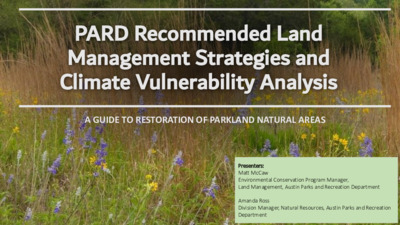1. Land Management Plan Presentation — original pdf
Backup

PARD Recommended Land Management Strategies and Climate Vulnerability Analysis A GUIDE TO RESTORATION OF PARKLAND NATURAL AREAS Presenters: Matt McCaw Environmental Conservation Program Manager, Land Management, Austin Parks and Recreation Department Amanda Ross Division Manager, Natural Resources, Austin Parks and Recreation Department BACKGROUND plants and animals. • A natural area is one with natural character, typically dominated by native • 74% of parkland (~12,500 acres) is designated as natural areas in Nature Preserves, Greenbelts, and other park types. • Natural areas provide critical services such as support for human health and well-being, climate regulation, clean air and water, and support for strong economies. 2 CHALLENGE 26% Developed/ mowed 74% Natural Areas PARD lands DEGRADED LANDS 0.2% Natural Areas 99.8% Developed/mowed lands, programs, admin PARD budget Most parkland natural areas have not been managed for ecosystem health and are degraded. As a result, they are threatened by heat, drought, disease, and wildfire and present safety risks to both park users and neighbors. 2019 WILDFIRE PREPAREDNESS AUDIT Found that PARD does not have the capacity to manage parkland natural areas and address wildfire risk. SOLUTION: ACTIVE ECOLOGICAL RESTORATION CLIMATE EQUITY PLAN Natural Systems Goal 1: Manage natural areas for resilience. Natural Systems Goal 4: Include all City-owned lands under a management plan that results in negative carbon emissions and maximizes co-benefits. 2019 WILDFIRE PREPAREDNESS AUDIT Recommended that PARD create and implement land management plans with a priority on “high-risk Response: PARD established the beginnings of a land management program as well as a technical properties.” guiding document to help direct action. OTHER INITIATIVES This strategy is also recommended by: • Austin/Travis County Community Wildfire Protection Plan • PARD Long Range Plan • Nine parks vision plans • Austin Green Infrastructure Strengths and Gaps Assessment • Austin Healthy Parks Plan (Austin Parks Foundation) LAND MANAGEMENT GUIDE SCOPE • 10,347 acres of natural areas • All PARD Nature Preserves and PARD Balcones Canyonlands Preserves • Contiguous natural areas > 75-100 acres • Excludes small and/or fragmented natural areas which provide difficult access and are expensive to manage • Creates large management complexes 5 LAND MANAGEMENT GUIDE COMPONENTS SITE ANALYSIS Current conditions and challenges. Existing vegetation communities, wildfire fuel conditions, soils, hydrology, endangered species, other elements CLIMATE VULNERABILITY ANALYSIS Defined the components of climate vulnerability. Identifies and maps vulnerability to intense heat, drought, disease, and wildfire. Incorporates social vulnerability as a component of risk. MANAGEMENT GOALS Vegetation types expected to be most resilient throughout 21st century RESTORATION STRATEGIES Actions for economically and efficiently achieving management goals at large scales MONITORING DIRECTION For evaluating progress relative to management goals 6 COMMUNITY INPUT PREVIOUS PUBLIC ENGAGEMENT Parks vision plans, Long Range Plan, Climate Equity Plan, Wildfire Preparedness Audit, existing community-supported projects Two presentations to Parks Board, City Council approval COMMUNITY INPUT DURING PLAN DEVELOPMENT Targeted and general outreach to 50+ stakeholder groups Input from 60+ key staff: Austin Water/BCP, Austin Fire Department, Watershed Protection, Office of Sustainability, Office of Resilience, Equity Office, Travis County Fire Marshall’s office, others COMMUNITY INPUT DURING IMPLEMENTATION Co-development of work plans and unified management of tracts with stakeholder groups 7 MAJOR FINDINGS AND RECOMMENDATIONS 2023 AUSTIN’S NATURAL AREAS • • 87.5% of Austin’s public natural areas are west of Interstate 35. 98.5% of all lands that have received ecological restoration activities are west of Interstate 35. Socially vulnerable communities depend heavily on healthy ecosystems for their health, well-being, and economic vitality. Most communities classified as high social vulnerability are located east of Interstate 35. CURRENT CHALLENGES • 76% of parkland natural areas are in Very Poor to Moderate condition due to invasive species, loss of biodiversity, and hazardous wildfire fuel conditions. Ecological condition affects the likelihood of widespread tree mortality and intense wildfire. Areas of elevated probability of intense wildfire are distributed throughout the park system. Areas of highest Climate Vulnerability Index are distributed throughout the park system but concentrated east of Mopac. Natural area condition class Poor-Very Poor Moderate Good-Very Good FUTURE CHALLENGES • Climate change is increasing the likelihood of widespread tree mortality and intense wildfire. The temperature conditions during the 2011 wildfire season are projected to be the average condition as soon as 2040. This means that as few as 17 years remain to prepare our natural areas for significant climatic stress. 8 • • • • • MAJOR FINDINGS AND RECOMMENDATIONS PROGRAM STRATEGY • Long-term, holistic restoration and management of parkland natural areas to mitigate risk, improve resilience, and secure ecosystem services. RESTORATION ACTIVITIES • Over 1,000 acres/year of restoration treatment are needed over the next ~20 years. o Selective thinning and fuel reduction: Targeted removal of small trees and brush to improve forest health o Prescribed fire: Important land management and wildfire o Invasive species removal: Improves climate resilience and mitigation tool park user safety o Planting and seeding: Improves climate resilience RESOURCE NEEDS • • Estimated annually at $200 per acre under management Staffing, equipment, operating funds, workspace PITCH DECK 9 Environmental Commission – August 2 NEXT STEPS City Council – August 31 REQUESTED ACTION: Recommend to Austin City Council to approve the Parks and Recreation Department Climate Vulnerability Analysis and Recommended Management Strategies. 10